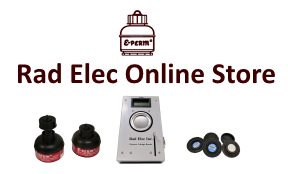
Rad Elec's Online Store is now open for business! Shop for your E-PERM® products at your convenience, at any time.
Your SPER-1/E voltage reader should be calibrated at least once a year. In order to have your reader calibrated, it is important to send your set of reference electrets along with it. In addition to the reader calibration certificate, you will also receive a re-certification for your reference electrets. There is a charge for the calibration, in addition to shipping and handling. The date of your reader's last calibration is written on a sticker located on the back of your instrument.
Fill out the Reader Calibration Form (located here), enclose it with your Reader and Reference Electret Set, and ship it to Rad Elec for calibration. If you are a "walk-in" customer, please call us in advance so that we can schedule your calibration date.
Reference electrets are extremely stable, and are used as part of your quality assurance program; as such, Rad Elec recommends that you maintain a record of your weekly reference electret readings. If your weekly reference electret readings remain essentially constant, you can be confident that your reader is functioning properly. If both of your reference electrets differ by more than ±1 volt than their previous weekly readings, try cleaning them thoroughly with nitrogen (although be careful not to touch the surface of the electret). If both of your reference electrets deviate by more than ±3 volts from their previous reading, it is recommended that you give Rad Elec a call (and probably plan on sending your voltage reader in for evaluation).
You can find the Reader Calibration Form right here.
The cost for a reader calibration is $135, plus shipping and handling.
Rad Elec endeavors to calibrate (and return) your reader on the same day that we receive it. However, some circumstances may cause a delay in the calibration (for example, if repairs are required). In the rare case that additional work is required, Rad Elec will contact you once the reader has been properly evaluated.
The reader should be kept in its carrying case to protect it from dust, dirt, and moisture. Preferably, the reader should be kept in a temperature-controlled environment. A desiccant located under the flap of the case should be checked periodically to see if it needs to be dried. If the silica gels have turned pink, then gently bake the desiccant in an oven (at approximately 200F/95C) at 30-minute intervals until the silica gels inside the desiccant turn blue.
You should change the batteries when the "LO BAT" indication appears on the display panel of the reader. Always use new alkaline batteries, and keep them paired together. The SPER1 and SPER1-A readers use a 9-volt battery, while the SPER1-E uses two AA batteries. The battery latch is located on the back of the instrument. The batteries will usually last for quite a long time (sometimes for a year or longer), so changing the batteries on your reader isn't a very common occurrence.
This malfunction can happen for a few different reasons. Firstly, this can occur on very humid summer days, or when moisture condenses inside the reader (e.g. when a cold reader is brought into a warm, damp room). Avoid leaving the reader in a hot or cold car, and then immediately performing a measurement afterward. Rad Elec recommends that the reader be used in air-conditioned rooms with a relative humidity of less than 75%. Furthermore, the reader should also be kept in its carrying case, and the desiccant should be checked at least once a month.
Another cause of fluctuating readings can be due to a dirty electret receptacle, which is preventing good contact with the reader. Clean the electret receptacle by dabbing a Q-tip with a bit of rubbing alcohol, and then "scrubbing" the diameter of the receptacle. After this is finished, clean the receptacle with nitrogen to make sure no fibers were left behind. When doing this, do not open the shutter and expose the interior while cleaning the receptacle.
If readings are still fluctuating, try to use an electret's keeper cap, and place it gently on the back of an electret after it has been placed on the reader's receptacle. Place one or two fingers on the keeper cap, applying a slight amount of pressure, and try to take three or four readings in a row. Consistency is key to making stable readings, so always try to pull the lever at the same interval, keep the electret properly aligned, and minimize any other variables that you may be introducing into an individual electret reading.